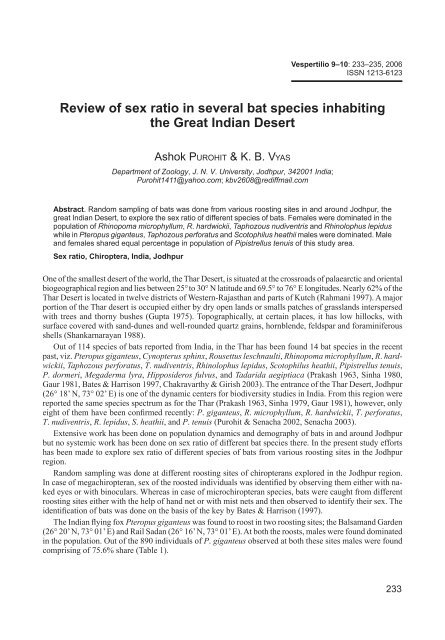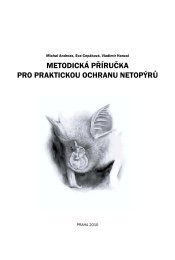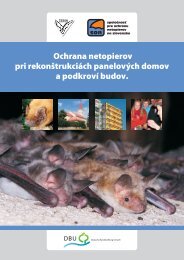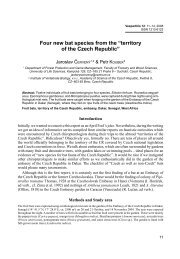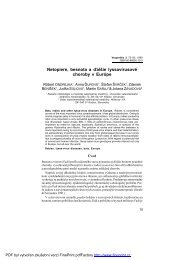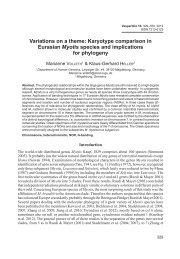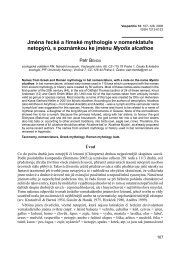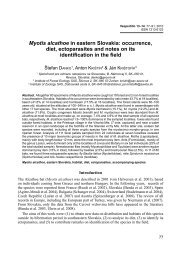Review of sex ratio in several bat species inhabiting the Great Indian ...
Review of sex ratio in several bat species inhabiting the Great Indian ...
Review of sex ratio in several bat species inhabiting the Great Indian ...
You also want an ePaper? Increase the reach of your titles
YUMPU automatically turns print PDFs into web optimized ePapers that Google loves.
Vespertilio 9–10: 233–235, 2006<br />
ISSN 1213-6123<br />
<strong>Review</strong> <strong>of</strong> <strong>sex</strong> <strong>ratio</strong> <strong>in</strong> <strong>several</strong> <strong>bat</strong> <strong>species</strong> <strong>in</strong>habit<strong>in</strong>g<br />
<strong>the</strong> <strong>Great</strong> <strong>Indian</strong> Desert<br />
Ashok PUROHIT & K. B. VYAS<br />
Department <strong>of</strong> Zoology, J. N. V. University, Jodhpur, 342001 India;<br />
Purohit1411@yahoo.com; kbv2608@rediffmail.com<br />
Abstract. Random sampl<strong>in</strong>g <strong>of</strong> <strong>bat</strong>s was done from various roost<strong>in</strong>g sites <strong>in</strong> and around Jodhpur, <strong>the</strong><br />
great <strong>Indian</strong> Desert, to explore <strong>the</strong> <strong>sex</strong> <strong>ratio</strong> <strong>of</strong> different <strong>species</strong> <strong>of</strong> <strong>bat</strong>s. Females were dom<strong>in</strong>ated <strong>in</strong> <strong>the</strong><br />
po pu la ti on <strong>of</strong> Rh<strong>in</strong>opoma microphyllum, R. hardwickii, Taphozous nudiventris and Rh<strong>in</strong>olophus lepidus<br />
while <strong>in</strong> Pteropus giganteus, Taphozous perforatus and Scotophilus heathii males were dom<strong>in</strong>ated. Male<br />
and females shared equal percentage <strong>in</strong> population <strong>of</strong> Pipistrellus tenuis <strong>of</strong> this study area.<br />
Sex <strong>ratio</strong>, Chiroptera, India, Jodhpur<br />
One <strong>of</strong> <strong>the</strong> smallest desert <strong>of</strong> <strong>the</strong> world, <strong>the</strong> Thar Desert, is situated at <strong>the</strong> crossroads <strong>of</strong> palaearctic and oriental<br />
biogeographical region and lies between 25° to 30° N latitude and 69.5° to 76° E longitudes. Nearly 62% <strong>of</strong> <strong>the</strong><br />
Thar Desert is located <strong>in</strong> twelve districts <strong>of</strong> Western-Rajasthan and parts <strong>of</strong> Kutch (Rahmani 1997). A major<br />
portion <strong>of</strong> <strong>the</strong> Thar desert is occupied ei<strong>the</strong>r by dry open lands or smalls patches <strong>of</strong> grasslands <strong>in</strong>terspersed<br />
with trees and thorny bushes (Gupta 1975). Topographically, at certa<strong>in</strong> places, it has low hillocks, with<br />
surface covered with sand-dunes and well-rounded quartz gra<strong>in</strong>s, hornblende, feldspar and foram<strong>in</strong>iferous<br />
shells (Shan kar na ra yan 1988).<br />
Out <strong>of</strong> 114 <strong>species</strong> <strong>of</strong> <strong>bat</strong>s reported from India, <strong>in</strong> <strong>the</strong> Thar has been found 14 <strong>bat</strong> <strong>species</strong> <strong>in</strong> <strong>the</strong> recent<br />
past, viz. Pteropus giganteus, Cynopterus sph<strong>in</strong>x, Rousettus leschnaulti, Rh<strong>in</strong>opoma microphyllum, R. hardwic<br />
kii, Taphozous perforatus, T. nudiventris, Rh<strong>in</strong>olophus lepidus, Scotophilus heathii, Pipistrellus te nuis,<br />
P. dormeri, Megaderma lyra, Hipposideros fulvus, and Tadarida aegiptiaca (Prakash 1963, S<strong>in</strong>ha 1980,<br />
Gaur 1981, Bates & Harrison 1997, Chakravarthy & Girish 2003). The entrance <strong>of</strong> <strong>the</strong> Thar Desert, Jodhpur<br />
(26° 18’ N, 73° 02’ E) is one <strong>of</strong> <strong>the</strong> dynamic centers for biodiversity studies <strong>in</strong> India. From this region were<br />
reported <strong>the</strong> same <strong>species</strong> spectrum as for <strong>the</strong> Thar (Prakash 1963, S<strong>in</strong>ha 1979, Gaur 1981), however, only<br />
eight <strong>of</strong> <strong>the</strong>m have been confirmed recently: P. giganteus, R. microphyllum, R. hardwickii, T. per fo ra tus,<br />
T. nudiventris, R. lepidus, S. heathii, and P. tenuis (Purohit & Senacha 2002, Senacha 2003).<br />
Extensive work has been done on population dynamics and demography <strong>of</strong> <strong>bat</strong>s <strong>in</strong> and around Jodhpur<br />
but no systemic work has been done on <strong>sex</strong> <strong>ratio</strong> <strong>of</strong> different <strong>bat</strong> <strong>species</strong> <strong>the</strong>re. In <strong>the</strong> present study efforts<br />
has been made to explore <strong>sex</strong> <strong>ratio</strong> <strong>of</strong> different <strong>species</strong> <strong>of</strong> <strong>bat</strong>s from various roost<strong>in</strong>g sites <strong>in</strong> <strong>the</strong> Jodhpur<br />
region.<br />
Random sampl<strong>in</strong>g was done at different roost<strong>in</strong>g sites <strong>of</strong> chiropterans explored <strong>in</strong> <strong>the</strong> Jodhpur region.<br />
In case <strong>of</strong> megachiropteran, <strong>sex</strong> <strong>of</strong> <strong>the</strong> roosted <strong>in</strong>dividuals was identified by observ<strong>in</strong>g <strong>the</strong>m ei<strong>the</strong>r with naked<br />
eyes or with b<strong>in</strong>oculars. Whereas <strong>in</strong> case <strong>of</strong> microchiropteran <strong>species</strong>, <strong>bat</strong>s were caught from different<br />
roost<strong>in</strong>g sites ei<strong>the</strong>r with <strong>the</strong> help <strong>of</strong> hand net or with mist nets and <strong>the</strong>n observed to identify <strong>the</strong>ir <strong>sex</strong>. The<br />
identification <strong>of</strong> <strong>bat</strong>s was done on <strong>the</strong> basis <strong>of</strong> <strong>the</strong> key by Bates & Harrison (1997).<br />
The <strong>Indian</strong> fly<strong>in</strong>g fox Pteropus giganteus was found to roost <strong>in</strong> two roost<strong>in</strong>g sites; <strong>the</strong> Balsamand Garden<br />
(26° 20’ N, 73° 01’ E) and Rail Sadan (26° 16’ N, 73° 01’ E). At both <strong>the</strong> roosts, males were found dom<strong>in</strong>ated<br />
<strong>in</strong> <strong>the</strong> population. Out <strong>of</strong> <strong>the</strong> 890 <strong>in</strong>dividuals <strong>of</strong> P. giganteus observed at both <strong>the</strong>se sites males were found<br />
compris<strong>in</strong>g <strong>of</strong> 75.6% share (Table 1).<br />
233
Table 1. Status <strong>of</strong> <strong>sex</strong> <strong>ratio</strong> <strong>of</strong> different <strong>species</strong> <strong>of</strong> <strong>bat</strong>s studied <strong>in</strong> <strong>the</strong> Jodhpur region<br />
Tab. 1. Pomer pohlaví u rôznych druhov netopierov skúmaných v regióne Jodhpuru<br />
Legend / legenda: N – total number <strong>of</strong> counted <strong>bat</strong>s for <strong>the</strong> <strong>sex</strong> <strong>ratio</strong> / celkový počet skúmaných netopierov;<br />
M – number <strong>of</strong> males / počet sam cov; F – number <strong>of</strong> females / počet samíc<br />
<strong>species</strong> / druh N M % F %<br />
Pteropus gi gan teus 890 674 75.7 216 24.3<br />
Rh<strong>in</strong>opoma microphyllum 248 94 37.9 154 62.1<br />
Rh<strong>in</strong>opoma hardwickii 73 23 31.5 50 68.5<br />
Taphozous perforatus 25 17 68.0 8 32.0<br />
Taphozous nudiventris 60 23 38.3 37 61.7<br />
Rh<strong>in</strong>olophus lepidus 32 12 37.5 20 62.5<br />
Scotophilus heathii 56 37 66.1 19 33.9<br />
Pipistrellus tenuis 89 48 53.9 41 46.1<br />
The microchiropteran <strong>bat</strong> <strong>species</strong> were caught <strong>in</strong> various roosts; Mandore Tunnel (26° 21’ N, 73° 02’ E),<br />
Deval <strong>of</strong> Maharaja Shri Gaj S<strong>in</strong>gh I (26° 21’ N, 73° 02’ E), Deval <strong>of</strong> Maharaja Shri Ajit S<strong>in</strong>gh (26° 02’ N,<br />
73° 02’ E), Palm Tree Plantation (26° 21’ N, 73° 02’ E) <strong>of</strong> <strong>the</strong> Mandore garden; Dark <strong>in</strong>terwoven cave <strong>of</strong><br />
Daijar Mata Temple (26° 23’ N, 73° 03’ E); An unattended bungalow <strong>of</strong> Krishna Nagar Colony (26° 14’ N,<br />
73° 02’ E); Sagi kee Bhakari <strong>of</strong> Jhalamand (26° 13’ N, 73° 07’ E), and Open Convocation Pandal <strong>of</strong> J. N.<br />
V. University (26° 15’ N, 73° 01’ E).<br />
It was observed that females were dom<strong>in</strong>ated <strong>in</strong> <strong>the</strong> populations over <strong>the</strong> males <strong>in</strong> <strong>the</strong> <strong>Great</strong>er mouse-tailed<br />
<strong>bat</strong>, Rh<strong>in</strong>opoma microphyllum, Lesser mouse-tailed <strong>bat</strong>, R. hardwickii; Naked-rumped tomb <strong>bat</strong>, Taphozous<br />
nudiventris, and Blyth’s horseshoe <strong>bat</strong>, Rh<strong>in</strong>olophus lepidus. Out <strong>of</strong> 248 <strong>in</strong>dividuals <strong>of</strong> R. micro phyl lum and<br />
73 <strong>in</strong>dividuals <strong>of</strong> R. hardwickii caught from different roosts <strong>in</strong> Jodhpur females were dom<strong>in</strong>ated by its 62.1%<br />
and 68.5% share, respectively, whereas <strong>of</strong> <strong>the</strong> 60 <strong>in</strong>dividuals sampled <strong>of</strong> T. nudiventris 61.7% were females.<br />
Likewise, out <strong>of</strong> 32 <strong>in</strong>dividuals <strong>of</strong> R. lepidus sampled, 62.5% were females (Table 1).<br />
However, males were found dom<strong>in</strong>ated <strong>in</strong> <strong>the</strong> populations <strong>of</strong> <strong>the</strong> Egyptian tomb <strong>bat</strong>, Taphozous perforatus<br />
and Asiatic <strong>Great</strong>er yellow house <strong>bat</strong>, Scotophilus heathii. Of <strong>the</strong> 25 <strong>in</strong>dividuals <strong>of</strong> T. perforatus sampled,<br />
68% were males, likewise out <strong>of</strong> 56 <strong>in</strong>dividuals <strong>of</strong> S. heathii, 66.1% were males (Table 1).<br />
Although no any population <strong>of</strong> <strong>Indian</strong> pygmy <strong>bat</strong>, Pipistrellus tenuis, could be located at roosts but <strong>the</strong><br />
samples <strong>of</strong> this <strong>species</strong> collected by deploy<strong>in</strong>g <strong>the</strong> mistnets <strong>in</strong> its forag<strong>in</strong>g area reveals that males and females<br />
shares almost equal percentage. Out <strong>of</strong> 89 <strong>in</strong>dividuals <strong>of</strong> P. tenuis caught at various places <strong>in</strong> Jodhpur males<br />
were dom<strong>in</strong>ated with 53.9% <strong>of</strong> its share (Table 1).<br />
Conclusively, <strong>in</strong> <strong>the</strong> Jodhpur region, it was observed that males were dom<strong>in</strong>ated <strong>in</strong> roosts <strong>of</strong> P. giganteus,<br />
T. perforatus, and S. heathii, while females dom<strong>in</strong>ated <strong>in</strong> roosts <strong>of</strong> R. microphyllum, R. hardwickii, T.<br />
nu di vent ris, and R. lepidus. Male and females shared equal percentage <strong>in</strong> population <strong>of</strong> Pipistrellus tenuis<br />
sam pled by mist-nett<strong>in</strong>g.<br />
Súhrn<br />
Prehľad pohlavného pomeru u niekoľkých druhov netopierov obývajúcich Veľkú Indickú púšť.<br />
S cieľom preskúmať pomer pohlaví rôznych druhov ne topierov v Jodhpure a v okolí vo Veľkej Indickej púšti<br />
sa realizovalo náhodné vzorkovanie netopierov v rôznych úkrytoch. V populáciách Rh<strong>in</strong>opoma microphyllum,<br />
R. hard wic kii, Taphozous nudiventris a Rhi no lo phus lepidus do mi no va li samice, u Pteropus gi gan teus, Taphozous<br />
perforatus a Scotophilus heathii pre vlá da li samce. Vyrovananý pomer samcov a samíc v sledovnom<br />
území sa zistil v populácii Pi pis t rel lus tenuis.<br />
234
Acknowledgements<br />
We are extremely thankful to <strong>the</strong> Department <strong>of</strong> Science and Technology, New Delhi for provid<strong>in</strong>g f<strong>in</strong>ancial grant through<br />
<strong>the</strong> Project No.- SP/SO/C-28/99 for this study. We are also grateful to <strong>the</strong> management <strong>of</strong> <strong>the</strong> wildlife <strong>of</strong>ficials <strong>of</strong> <strong>the</strong> city<br />
for grant<strong>in</strong>g permission to conduct <strong>the</strong> study and Additional Director, ZSI, Jodhpur for provid<strong>in</strong>g GPS Unit.<br />
References<br />
BATES P. J. J. & HARRISON D. L., 1997: Bats <strong>of</strong> <strong>the</strong> <strong>Indian</strong> subcont<strong>in</strong>ent. Harrison Zoological Museum,<br />
Sevenoaks, 258 pp.<br />
CHAKRAVARTHY A. K. & GIRISH A. C., 2003: Crop protection and conservation <strong>of</strong> frugivorous <strong>bat</strong>s <strong>in</strong> orchards<br />
<strong>of</strong> hill and coastal region <strong>of</strong> Karnataka. Zoos Pr<strong>in</strong>t J., 18: 1169–1171.<br />
GAUR B. S., 1981: Ecology <strong>of</strong> Bats <strong>of</strong> <strong>the</strong> <strong>Indian</strong> Desert. Unpublished Ph.D. Thesis, Jodhpur University,<br />
Jodhpur, 110 pp.<br />
GUPTA R. K. 1975: Plant life <strong>in</strong> Thar. Environmental analysis <strong>of</strong> <strong>the</strong> Thar desert. Pp.: 202–236. In: GUPTA<br />
R. K. & PRAKASH I. (eds.): Enviornmental Analysis <strong>of</strong> <strong>the</strong> Thar Desert. English Book Depot, Dehra Dun,<br />
484 pp.<br />
PRAKASH I., 1963: Taxonomic and biological observation on <strong>the</strong> <strong>bat</strong>s <strong>of</strong> <strong>the</strong> Rajasthan desert. Rec. <strong>Indian</strong><br />
Mus., 59: 149–170.<br />
PUROHIT A. & SENACHA K. R., 2002: A review <strong>of</strong> microchepteran eco-status <strong>in</strong> Mandore garden, Jodhpur. J.<br />
Nature Cons., 14: 251–262.<br />
RAHMANI A. R., 1997: The effect <strong>of</strong> Indira Nahar Project on <strong>the</strong> avifauna <strong>of</strong> <strong>the</strong> Thar desert. J. Bombay Natur.<br />
Hist. Soc., 94: 233–266.<br />
SENACHA K. R., 2003: Eco-status and Demographic Changes among Chiropterans <strong>of</strong> <strong>the</strong> Thar Desert with<br />
Special Reference to Jodhpur. Unpublished Ph. D. Thesis. J. N. Vyas University, Jodhpur, 175 pp.<br />
SHANKARNARAYAN K. A., 1988: Ecological degradation <strong>of</strong> <strong>the</strong> Thar Desert and ecoregene<strong>ratio</strong>n. Desert Ecol.,<br />
1988: 1–3.<br />
SINHA Y. P., 1979: Studies on Taxonomy, Distribution, Zoogeography, Osteology and Field Ecology <strong>of</strong> Bats<br />
<strong>of</strong> Rajasthan, specially <strong>the</strong> <strong>Indian</strong> Desert. Unpblished Ph.D. dissertation. Jodhpur University, 204 pp.<br />
SINHA Y. P., 1980: The <strong>bat</strong>s <strong>of</strong> Rajasthan: taxonomy and zoogeography. Rec. Zool. Survey India, 76: 7–63.<br />
received 8. 7. 2005<br />
235


